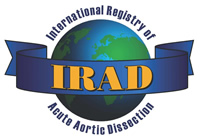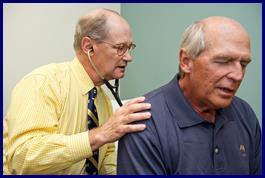 Founded in 1996, the International Registry of Acute Aortic Dissection has continued to shape the medical community’s understanding of aortic disease. A quarter century of research is an opportune time to reflect on the future of this endeavor, and much of the past year has been dedicated to revising the way in which IRAD approaches its mission. Somewhat paradoxically, these changes will promote the same goal that began with a grassroots organization and handful of passionate centers 25 years previous: to study the epidemiology, management, and outcomes of an uncommon but devastating emergency.
Founded in 1996, the International Registry of Acute Aortic Dissection has continued to shape the medical community’s understanding of aortic disease. A quarter century of research is an opportune time to reflect on the future of this endeavor, and much of the past year has been dedicated to revising the way in which IRAD approaches its mission. Somewhat paradoxically, these changes will promote the same goal that began with a grassroots organization and handful of passionate centers 25 years previous: to study the epidemiology, management, and outcomes of an uncommon but devastating emergency.
Sustainable growth has been a goal for the registry since it began. In 2012, it was determined that any subsequent growth would need to be self-sustaining, leading to the development of a payment-based model. This model has undergone significant changes in the previous year, leading to a 37.5% increase in the number of signed registry agreements. Supported by a robust training program for new participants, the addition of new sites has been shown to be a feasible and reliable way to increase IRAD enrollment and broaden the registry’s reach.
 Parsimony is a key element to IRAD’s success. As a voluntary registry, the demands on sites cannot outweigh the time available for abstraction and validation. However, myriad advances in the field, especially related to endovascular therapies, surgical repair, imaging, and genetics, have necessitated updates over time. Launched in 2010, the IRAD Interventional Cohort has been an example of how the registry can grow and adapt to change while maintaining data integrity. Recent publications have focused on IRAD-IVC data, and IRAD has been prominently featured at many of the larger surgical conferences.
Parsimony is a key element to IRAD’s success. As a voluntary registry, the demands on sites cannot outweigh the time available for abstraction and validation. However, myriad advances in the field, especially related to endovascular therapies, surgical repair, imaging, and genetics, have necessitated updates over time. Launched in 2010, the IRAD Interventional Cohort has been an example of how the registry can grow and adapt to change while maintaining data integrity. Recent publications have focused on IRAD-IVC data, and IRAD has been prominently featured at many of the larger surgical conferences.
There remains remarkable interest in analyzing the IRAD database, even after achieving 105 peer-reviewed publications. The coordinating center received 20 unique proposals for consideration this year alone, and 16 projects are actively undergoing analysis or waiting on journal review. Efforts to improve the organization and oversight of these many projects led to the development of the IRAD Publications Committee, launched in January 2021. This committee is comprised of highly active and democratically-elected members of the consortium. The committee meets quarterly to review potential projects, discuss target conferences and journals for ongoing projects, and support authors throughout the submission process. With this new initiative, IRAD aims to improve the percentage of projects that are ultimately published as well as increase engagement and ownership among invested centers.
IRAD has succeeded in the goal to better understand aortic dissection because of the dedication of its participants. This commitment is still readily apparent after 2.5 decades of research-from the dozens of topics analyzed yearly to the continued efforts to improve IRAD’s organization and outreach. Steadfast support from IRAD’s investigators, coordinators, funders, and patients has expanded our knowledge of aortic disease and created an infrastructure that will promote the discovery of novel insights well into the future.